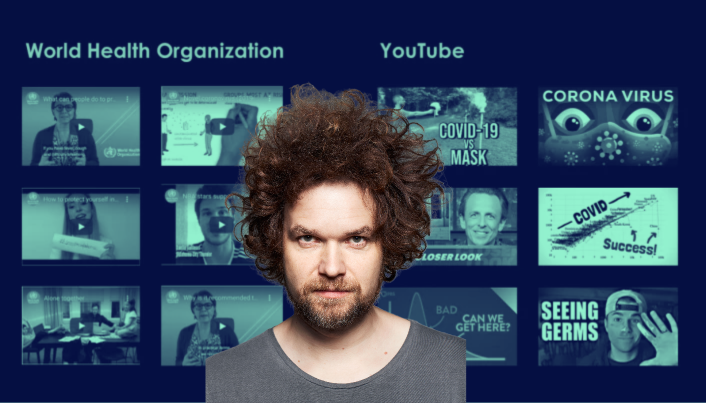The aim of the COVCOM project is to research the use of video for communicating complex, but important health messages about pandemics, primarily to the general population. The project is threefold: A qualitative study where we lay the groundwork through interviews and literature reviews; a creative study where we explore the creation of video communication; and a quantitative study where we test video communication in controlled experiments.
Jo Røislien
Trond Mohn Foundation University of Stavanger Stavanger University Hospital Norwegian Air Ambulance Foundation Leiden University
Ten academic papers have been published or submitted for publication, with a few more planned for 2023. Many of the results are directly applicable to science communicators, both in public health and other fields, and the project focuses on making results available also outside of academia.

The interviews and literature reviews have revealed multiple useful insights regarding how people perceive and act on pandemic information, characteristics of the types of communication that tend to work and not, and the struggle both health experts and communicators have when faced with the need to pinpoint what information to focus on, and how to balance scientific rigor with the need for simplification and clarity of message in order to reach out to large audiences.
The study has also found a creative gap between health authorities and professional media creators in their video communication, accompanied by limited outreach. Closely following industry professionals when creating pandemic videos has resulted in valuable insights into their creative processes, and new methodologies for how this can be utilized by the health authorities is in development and aid collaboration between the scientific community and professional communicators.
In laboratory experiments we have tested various non-visual factors in video communication in a stylized manner, assessing effects on comprehension and attitudes in a randomized controlled trial (RCT). The study found that comprehension and trust were positively impacted by using a formal expert source, and by including a call to action, irrespective of the topic being communicated. Neither of the variables explore were found to have an effect in intention. Towards the end of 2021 a large-scale RCT, with thousands of participants, was run, testing outcomes of four professionally made videos explaining virus transmission in four distinctly different ways. Analysis was performed fall 2022, and a scientific article presenting the study is currently in preparation. A new RCT aimed at testing the four videos on a younger audience is also planned. Shorter edits of the four videos have also been commissioned, in order to explore the effect of video length.
The main part of the project is over, with most of the data collection and academic groundwork done. Ten academic papers have already been published or submitted for publication, with a few more planned for 2023. The project participants have presented the COVCOM project on numerous national and international conferences, as well as for various academic and non-academic institutions and audiences. The project was the only project from the Research Council of Norway’s Call for Covid-19 related projects spring 2020 with an individual project presentation at the program’s closing conference in September 2022.
Many of the COVCOM project’s results are directly applicable to science communicators, both in public health and other fields, and the project focuses on making results available also outside of academia. Two chronicles and op-eds are already published, and more popular science articles are planned, both in national and international media outlets. Røislien has also given several interviews on radio and in the written press about the project. He is currently writing a popular science book about some of the more applicable key results from the project. The book has planned publication spring 2023 with one of Norway’s largest publishers of general interest literature.
Selected publications:
- Røislien J, O'Hara JK, Smeets I, Brønnick K, Berg SH, Shortt MT, Lungu DA, Thune H, Wiig S. Creating Effective, Evidence-Based Video Communication of Public Health Science (COVCOM Study): Protocol for a Sequential Mixed Methods Effect Study. JMIR Res Protoc 2022; 11(3): e34275. doi: 10.2196/34275 PMID: 35147500
- Shortt MT, Berg SH, Wiig S, Lungu DA, Smeets I, Thune H, Røislien J. Exploring Health experts’ and Creative Communicators’ Focus in Pandemic Video Communication: A Qualitative Study. Frontiers in Communication. 30 May 2022; 7:886768 doi: 10.3389/fcomm.2022.886768
- Berg SH, Shortt MT, Røislien J, Lungu DA, Thune H, Wiig S. Key topics in pandemic health risk communication: A qualitative study of expert opinions and knowledge. PlosOne. 2022 Sep 30;17(9):e0275316. doi: https://doi.org/10.1371/journal.pone.0275316. eCollection 2022.
- Berg SH, Lungu DA, Brønnick K, Harthug S, Røislien J. Exponential Growth Bias of Infectious Diseases: Protocol for a Systematic Review. JMIR Res Protoc 2022;11(10):e37441. doi: 10.2196/37441
SHARE RESEARCHERS
- Professor Jo Røislien (Project manager)
- Professor Siri Wiig
- Professor Kolbjørn Kallesten Brønnick
- Dean of Research Henriette Thune (PhD)
- Postdoctoral candidate Siv Hilde Berg
- Postdoctoral candidate Marie Therese Shortt
- Postdoctoral candidate Daniel Lungu
PARTNERS
- Professor Jane O’Hara, University of Leeds, UK.
- Professor Ionica Smeets, Leiden University, The Netherlands
- Professor Stig Harthug, Haukeland University Hospital and University of Bergen, Norway
- Professor Stephen Sollid, Stavanger University and Norwegian Air Ambulance, Norway
- Research Director and Associate professor Svein Skeie, Stavanger University Hospital and University of Bergen, Norway
- Martha Strandos, Head of Centre for Developing Institutional and Home Care Services Sogn and Fjordane, Norway
ADVISORY BOARD
- Anja Schou Lindman, Department Director Health Services Research, National Institute of Public Health, Norway
- Professor Jeffrey Braithwaite, Macquarie University, Australia
- Professor Morten Sodemann, University of Southern Denmark, Denmark
- Johnny Advocaat-Vedvik, Department Director, The Directorate of Health, Norway
- Janne Espevalen, Client Director and Partner, Anorak Oslo, Norway
COLLABORATORS PRIVATE SECTOR
- Science Addiction
- Bulldozer Film
- Nordic Screens
- Dagbladet
- Anorak